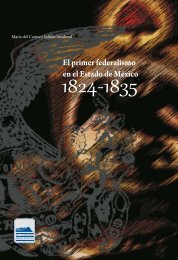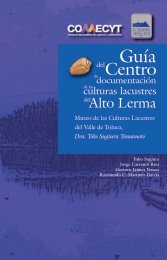Korpus 21 - Vol. 3
Korpus 21 - Nuevas interpretaciones acerca de la consumación de la Independencia.
Korpus 21 - Nuevas interpretaciones acerca de la consumación de la Independencia.
Create successful ePaper yourself
Turn your PDF publications into a flip-book with our unique Google optimized e-Paper software.
JOHN TUTINO, 18<strong>21</strong>: THE END OF NEW SPAIN, DREAMS OF AN IMPOSSIBLE MEXICO<br />
A different mix of power and loyalty, insurgency<br />
and persistence marked the basins<br />
around Mexico City, the heartland of silver<br />
capitalism. In zones of fertile well-watered<br />
lands –temperate and maize (and wheat)<br />
growing from the Toluca basin to the Chalco<br />
plain, tropical and sugar producing south<br />
around Cuernavaca– pressures of population<br />
growth on community lands had been compensated<br />
by access to seasonal wage work<br />
at nearby estates, negotiated by communitybased<br />
labor captains, keeping community-based<br />
family lives sustainable past 1800.<br />
Pueblos around Toluca showed no interest<br />
in rising with Hidalgo when he arrived in the<br />
fall of 1810; most around Cuernavaca held<br />
aloof from Morelos when he came to Cuautla<br />
in 1810. Most heartland indigenous republics<br />
remained at peace and at work from 1810<br />
to 1820 –a key to sustaining loyal power in<br />
Mexico City as silver capitalism collapsed.<br />
The dry basins of the northern heartland<br />
faced greater challenges during the<br />
last years of silver capitalism, leading many<br />
to years of insurgency after 1810. The arid<br />
lands around Otumba and extending into<br />
the Mezquital lay between the capital and<br />
the mines at Real del Monte. Estates there<br />
raised maize where irrigational allowed,<br />
grazed hogs, and focused on making pulque<br />
to supply taverns in the capital and at the<br />
mines. The richest of oligarchs profited: the<br />
Conde de Regla who ruled mining at Real del<br />
Monte and his wife, Condesa de Jala, all but<br />
monopolized the provision of pulque to the<br />
capital. The turn to pulque in the eighteenth<br />
century served landed oligarchs well, generating<br />
profit while employing little labor.<br />
When population growth left the region’s<br />
Otomí communities short of land to sustain<br />
growing populations around 1800, conflicts<br />
escalated. In the wake of Hidalgo’s revolt,<br />
which passed just west, in 1811 Mezquital villagers<br />
turned to rebellion, attacking estates,<br />
taking produce and land, undermining<br />
commercial production, bringing mining to<br />
a halt at Real del Monte. Silver production<br />
and the revenues it generated plummeted,<br />
as did the earnings of key landed oligarchs<br />
–a challenge from below that began to wane<br />
in 1815, with full pacification delayed to 1816<br />
(Tutino, 2018, Ch.4).<br />
If Mexico City was the financial and commercial<br />
pivot of silver capitalism, and the<br />
surrounding basins mixing mines at Taxco<br />
and Real del Monte and commercial estates<br />
and indigenous republics everywhere, was<br />
its heartland –the Bajío was the productive<br />
engine of silver capitalism, with the mines of<br />
Guanajuato sustained by manufacturing at<br />
Querétaro, San Miguel, and other towns, all<br />
fed by capitalist estates worked by resident<br />
families without rights to land or self-rule.<br />
After centuries of dynamic stability, recent<br />
predations mixing evictions and wage cuts<br />
deepened in the face of draught and profiteering<br />
from 1808 to 1810 –driving the popular<br />
risings that began in September of<br />
1810 and lasted into 1820. Yet insurgency<br />
was not everywhere. Peace and production<br />
held just east around Querétaro, where estate<br />
–dependent communities, more Otomí<br />
than mixed, had faced parallel predations–<br />
cushioned by informal community organizations.<br />
Most stayed at work, claiming gains<br />
in land use and wages too, while sustaining<br />
the regime (Tutino, forthcoming, Ch. 4 on<br />
Guanajuato; Ch. 5 on Querétaro).<br />
Across the rural basins surrounding the<br />
Guanajuato mines, the richest estates in the<br />
kingdom saw tens of thousands rise with Hidalgo<br />
in 1810, then return home to rule rich<br />
irrigated bottomlands and nearby upland<br />
basins through 1818 –with final pacifications<br />
in 1820. Communities took over estates, claimed<br />
land for family production, and sustained<br />
guerrilla bands. The limited mining that<br />
continued at Guanajuato after 1812, was carried<br />
on by independent workers who gave<br />
small shares to mine owners, then sold ore<br />
to refiners –all sustained by the produce of<br />
insurgent communities. Mine workers and<br />
rural families claimed productive autonomies<br />
as silver capitalism fell (Tutino, 1998,<br />
and forthcoming, Ch. 3).<br />
When rural pacification began in 1818, loyalist<br />
commanders learned that Bajío communities<br />
would only accept amnesties when<br />
guaranteed rights to cultivate lands they<br />
had claimed in insurgency and worked for<br />
342


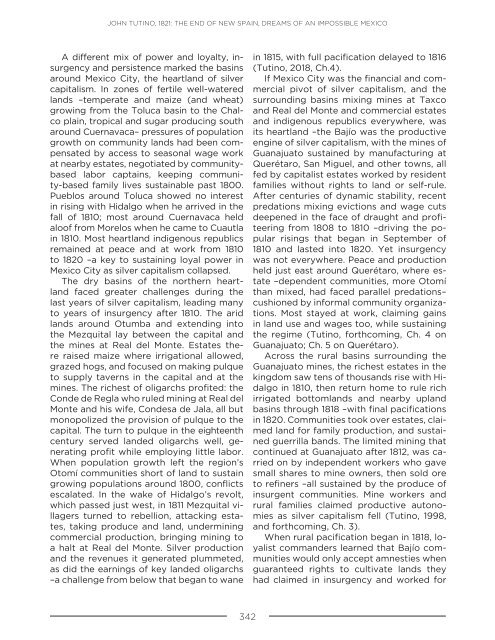
![bicentenario_1[V2]](https://img.yumpu.com/68677971/1/167x260/bicentenario-1v2.jpg?quality=85)
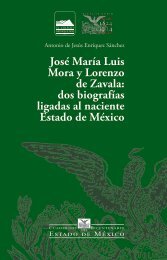
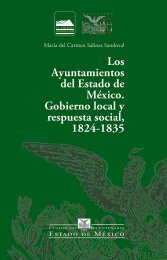

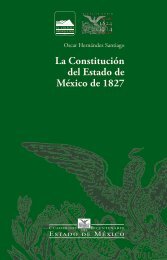
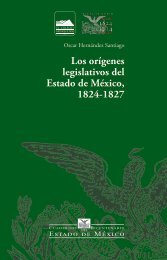
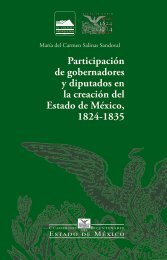
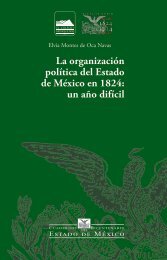
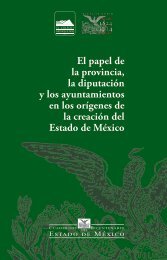

![El_primer_federalismoEM[final]_compressed (2)](https://img.yumpu.com/68483279/1/178x260/el-primer-federalismoemfinal-compressed-2.jpg?quality=85)
